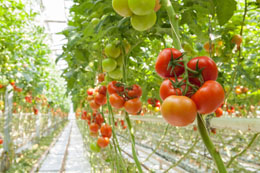Growing hydroponic tomatoes at home is not a difficult task. All you need is a hydroponic kit, basic supplies, and a little knowledge about water gardening.

Hydroponics is a new gardening technique, different from the regular way of growing plants. The finding that plants take up nutrients from water in the form of inorganic ions is the base for the development of hydroponic gardening. Soil acts a medium for supplying nutrients and supporting the root system, but it is not directly involved in the growth and development of plants. Hence, if we provide the necessary nutrients in another way, plants still continue to grow, and bear flowers and fruits.
Under the methodology of hydroponics, vegetables are grown in a soilless medium, after enriching it with essential plant nutrients. The result of this soilless gardening is really impressive. For some cultivars, the yield is much higher than regular plant growing techniques. Although mass scale cultivation of crops is not so easy, you can try growing hydroponic tomatoes, onions, cucumbers, culinary herbs, and other seasonal vegetables at home.
Commercial growing of hydroponic tomatoes is done in greenhouses. The general advantages of hydroponics are:
- It does not require soil preparation
- Easy regulation of nutrient quantity
- Less water usage
- Easy control of pests
- Stable crop production
The major disadvantage with hydroponic gardening is the high cost for setting up the plant and more importantly, you should know the basic concept behind soilless culture. If you are thorough with these requirements, you can experiment growing the tomatoes hydroponically at home.
Required Supplies
Nowadays, most garden supplies sell hydroponic systems for home growers. You can select a kit of a particular size, based on your budget and requirements. Other supplies needed to start a hydroponic project for growing tomatoes are plant nutrients, tomato plantlets, supporting stakes, measuring spoons, and a light source (if necessary). It is to be borne in mind that hydroponic tomato seeds are no different from regular tomato seeds.
Growing Hydroponic Tomatoes
Once you have the supplies ready, decide where you want to maintain your hydroponic system. In case you do not want hassles of installing artificial lighting, it is best to place the system near a window, balcony, or on the porch. The only thing is to protect the plants from night frost. The next step for starting hydroponic gardening is setting up the system with reference to the given instructions.
Refer to the guidelines while filling up water, especially for maintaining the water quality and levels. Then add the nutrients as per the recommended concentrations. Ensure that you measure the ingredients in accurate amounts, and add them in the water. Lower or higher concentration can reduce tomato yields. Having done this, clean the rocks provided with the kit (if any), and add in the hydroponic system.
Now, you are ready to introduce tomato plants in your hydroponic system. Gently remove the plantlets from the pot or container. Try removing the adhering soil particles from the roots as far as possible. You can wash the roots to get rid of soil components. Then, place the tomato plants in the system and cover their roots with rocks. This will support them and prevent them from bending.
Complete the installation part (hose and drip ring) for growing the tomatoes. Start the system and check for proper functioning. If you notice water dripping from the ring at regular intervals, then it is working fine. After you have completed setting up the system, the next steps are focused on maintaining it, such as regular filling of water and supplementing nutrients.
You may need to change some portion of water on a regular basis, say once in two weeks. Follow the basic tips for staking and pruning tomato plants, particularly when they reach to a height of about 2 feet. With correct water levels and proper nutrients, your hydroponic tomatoes will develop flowers, and you can soon enjoy homegrown hydroponic tomatoes.






 Hydroponics is a new gardening technique, different from the regular way of growing plants. The finding that plants take up nutrients from water in the form of inorganic ions is the base for the development of hydroponic gardening. Soil acts a medium for supplying nutrients and supporting the root system, but it is not directly involved in the growth and development of plants. Hence, if we provide the necessary nutrients in another way, plants still continue to grow, and bear flowers and fruits.
Hydroponics is a new gardening technique, different from the regular way of growing plants. The finding that plants take up nutrients from water in the form of inorganic ions is the base for the development of hydroponic gardening. Soil acts a medium for supplying nutrients and supporting the root system, but it is not directly involved in the growth and development of plants. Hence, if we provide the necessary nutrients in another way, plants still continue to grow, and bear flowers and fruits.